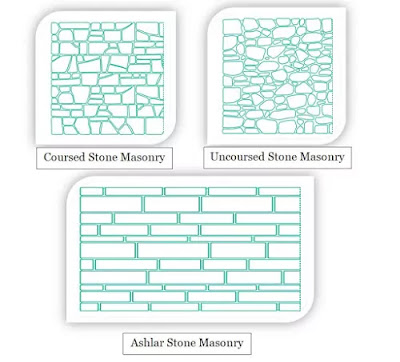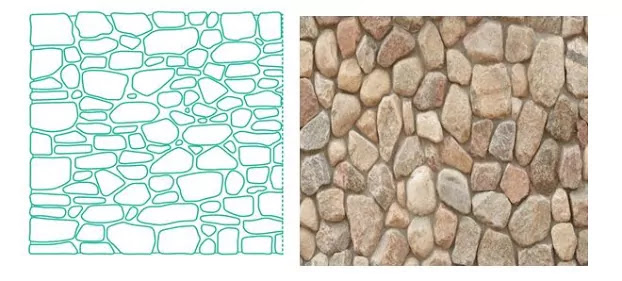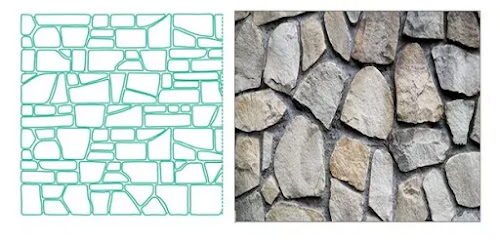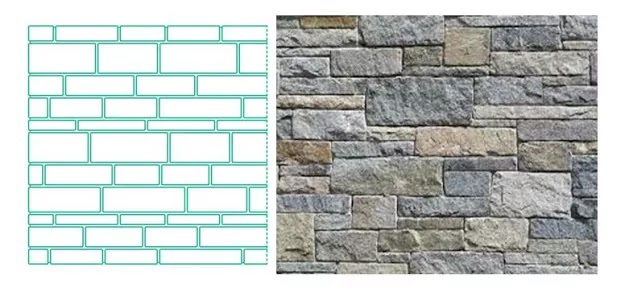What Are The Standard Specification of Type of Stone Masonry?

Hello, guys here i have explained what are the stone masonry standard specifications for good quality of stone masonry work. I hope you like this article, read it completely.
There are basically three types of masonry widely used in all countries. I have explained these three masonry with the proper ratio of cement mortar or lime mortar.
Here are stone masonry specifications:
(1) Uncoursed Rubble Stone Masonry In lime/cement mortar 1:6 in the superstructure
(2) Coursed Random Rubble Stone Masonry in lime/cement mortar 1:6 in Superstructure
(3) Ashlar Stone Masonry in lime/cement mortar 1:6 in Superstructure
(1) Uncoursed Rubble Stone Masonry: In lime / Cement Mortar 1:6 In The Superstructure

(A) Materials :
(i) Stone :
The stone shall be hard, sound, and free decay and weathering and of approved quality. The size of stone shall not be less than 15 cm in any direction stone shall be hammer dressed to secure close joint so that the stones when laid will come into close proximity stone with round surface shall not be used. Cement and sand for cement mortar or lime and surkhi (sand) for lime mortar small be of standard specifications.
(ii) Mortar :
Mortar shall be as specified, may be of cement mortar (1:3 to 1:6) or lime mortar (1:2 to 1:3) Mortar shall be first dry mixed to have the required proportion and then mixed with water by adding water slowly and gradually and mixed thoroughly to get a uniform mortar of workable consistency. Freshly mixed mortar shall be used, Joints shall not be thicker than 2 cm. face joints shall be thinner.
(B) Laying :
All stones shall be thoroughly wetted before laying. The walls shall be carried up truly plumb.
Face stone shall not be narrower than its height and shall tail back and bond well into the backing. The stones shall be arranged to break joint on the face for at least half the height with those of courses above or below.
The thickness of joints shall not be more than 2 cm. Stones shall be laid with Broader face downward to give good bedding Cornerstones of quoins should be a good stone and dressed to correct angle and laid as headers and stretchers.
The Interstices between stones shall be wedged with stone chips and spalls to avoid thick beds of joints and mortar.
Through stones : Through bond stones of one piece shall be provided and for every 0.5 sq.m of face and should extend to the full thickness of the wall. For walls thicker than 75 cm, bond stone may be of two pieces placed side by side overlapping at least 15 cm. Breadth of bond stones shall not be less than 1.5 times the height. Not more than 60 cm height of wall shall be constructed at a time. If any part of a wall is required to be raised in advance, tooting must be formed by giving projections to bond with the wall to be built later.
(C) Curing
The work shalt be protected from rain or sun while it is green At the end of the day’s work the tops of walls shall be left flooded. The masonry shall be kept moist on all the faces for at least 7 days.
(D) Measurement:
The Uncoursed random rubble masonry work shall be taken in cu.m after measuring Length. breadth and thickness to the nearest 1 cm. The rate of item Include the cost of scaffolding.
(2) Coursed Random Rubble Stone Masonry In Lime / Cement Mortar 1:6 In Superstructure
(A) Materials :
(ii) Stones :
Stones shall be hammer dressed on bed and top and also on sides so that stones will come to close proximity and each stone can be laid in course.
The stone shall be hard, sound and free from decay and weathering and of approved quality. The size of the stone shall not be less than 15 cm in any direction Stone with round surface shall not be used.
(ii) Mortar :
Mortar shall be as specified, may be of cement mortar (1:3 to 1:6)or lime mortar (1:2 to 1:3) Mortar shall be first dry mixed to have the required proportion and then mixed with water by adding water slowly and gradually and mixed thoroughly to get a uniform mortar of workable consistency. Freshly mixed mortar shall be used. Joints shall not be thinker than 2 cm. face joints shall be thinner.
(B) Laying:
All stones shall be thoroughly wetted before laying stone shall be laid with broader face downward and vertical joints should be broken. All courses shall be truly horizontal and all joints shall be full of mortar. Outer faces of stones shall be squared by hammer dressing to give a good appearance, and faces of wall shall be truly in plumb.

Through stones Through bond stones of alone place shall be provided with an Interval a through stone not less than 1.5 m In each course. For walls up to 60 cm thickness shall extend from and face of the wall to other. But in case of walls of greater thickness, band stone may be of two pieces placed side by side overlapping at least 15 cm.
(C) Curing :
The work shall be protected from rain or sun while it is fresh. At the end of the day’s work the tops of walls shall be left flooded. The masonry shall be kept most on all the fares for at least 7 days.
(D) Measurement:
The random rubble masonry work shall be taken in cu.m after measuring length. breath and thickness to the nearest 1 cm. The rate of item Include the cost of scaffolding.
(A) Materials :
(i) Stones :
The stone shall be hard, tough. round and durable of approved quality. Stones shall be chisel dressed on all sides to have perfectly square or rectangular faces so that they may be laid in perfectly horizontal and vertical joints.
The minimum height of stone shall be 20 cm and breadth not less than 1.5 time the height.
(ii) Mortar :
Mortar shall be as specified, rich fine mortar shall be used. maybe of cement mortar 1:2 to 1:6 or lime mortar 1:1 to 1:2. Materials of mortar eg. cement or lime and sand shall be of standard specifications.
Mortar shall be first dry mixed to have the required proportion and then water is added slowly and gradually and mixed thoroughly to get a uniform mortar of workable consistency. Freshly mixed mortar shall be used.
(B) Laying :
The stones shall be wetted before laying. Stones shall be laid in regular courses. of not less than 14.5 cm in height and all the courses shall be of the same height. All courses shall be laid truly horizontal and all vertical joints shall be truly vertical. Face stones shall be laid header and stretcher respectively. No joint shall be thicker than 3.5 mm.
If pointing is not provided as separate then , the joints shall be struck and finished at the time of laying. Not more than 60 cm height of masonry shall be constructed at a time.
(C) Curing :
The work shall be protected from rain or sun while it is fresh. At the end of the days work The tops of walls shall be left flooded. The masonry shall be kept most or all the faces for at least 7 days.
(D) Measurement :
The ashlar masonry work shall be taken in cu.m after measuring length breadth and thickness to the nearest 1 cm. The rate of item Include the cost of scaffolding.
I Hope You Like Our Article “Stone Masonry Specifications of All 3 Types – Civil Engineering Must know” Don’t be Cheap To Share This Article with your Friends.
- Innovation in Civil Engineering “solar roadway”
- How to solve any structural beam in smartphone within 2 minute ?
- How to construct a foundation in black cotton soil ?



